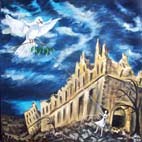
The English version of the official website of the abbey has a wealth of information about the life of the founder, St Benedict, and the history of the abbey itself. I don't find the website particularly user-friendly, and the legal note warns that images and text cannot be reproduced, other than for personal use, so I wont reproduce any of it here. However, if you have time to spend and don't mind lots of clicks, you will learn much about the abbey and St Benedict through the site.
The Catholic Online site has no copy-right warnings that I could find, so I have reproduced an extract about St Benedict from the Saints and Angels page:
In the fifth century, the young Benedict was sent to Rome to finish his education with a nurse/housekeeper. The subject that dominated a young man's study then was rhetoric -- the art of persuasive speaking. A successful speaker was not one who had the best argument or conveyed the truth, but one who used rhythm, eloquence and technique to convince. The power of the voice without foundation in the heart was the goal of the student's education. And that philosophy was reflected in the lives of the students as well. They had everything -- education, wealth, youth -- and they spent all of it in the pursuit of pleasure not truth. Benedict watched in horror as vice unraveled the lives and ethics of his companions.
Afraid for his soul, Benedict fled Rome, gave up his inheritance, and lived in a small village with his nurse. When God called him beyond this quiet life to even deeper solitude, he went to the mountains of Subiaco. There he lived as a hermit under the direction of another hermit, Romanus. After years of prayer, word of his holiness brought nearby monks to ask for his leadership. He warned them he would be too strict for them, but they insisted -- then tried to poison him when his warning proved true.
So Benedict was on his own again -- but not for long. The next set of followers were more sincere and he set up twelve monasteries in Subiaco where monks lived in separate communities of twelve.
He left these monasteries abruptly when the envious attacks of another hermit made it impossible to continue the spiritual leadership he had taken.
But it was in Monte Cassino he founded the monastery that became the roots of the Church's monastic system. Instead of founding small separate communities he gathered his disciples into one whole community. His own sister, Saint Scholastica , settled nearby to live a religious life.
After almost 1500 years of monastic tradition his direction seems obvious to us. But Benedict was an innovator. No one had ever set up communities like his before or directed them with a rule. What is part of history to us now was a bold risky step into the future.
Benedict had the holiness and the ability to take this step. His beliefs and instructions on religious life were collected in what is now known as the Rule of Saint Benedict -- still directing religious life after 15 centuries.
In this tiny but powerful Rule, Benedict put what he had learned about the power of speaking and oratorical rhythms at the service of the Gospel. He did not drop out of school because he didn't understand the subject! Scholars have told us that his Rule reflects an understanding of and skill with the rhetorical rules of the time. Despite his experience at school, he understood rhetoric was as much a tool as a hammer was. A hammer could be used to build a house or hit someone over the head. Rhetoric could be used to promote vice ... or promote God. Benedict did not shun rhetoric because it had been used to seduce people to vice; he reformed it.
Here is Wikipedia's entry, lengthy, interesting, but not so lyrical! Another interesting link is this one, from the Benedictine Sisters in Indiana, where the writer links the teachings of St Benedict to society today.
The question I pose, to you and to myself, is what are we, as artists, doing to put into practice what we are happy to preach? Probably living as a hermit in a cave is not the best option today, but the message of love and peace begins, I believe, with us in our personal lives. As dedicated peace worker Bruno Picozzi said to me, we can't change the world, many have tried and failed. But we can change ourselves, and as we change, so do those around us, and so it can spread, each of us becoming the best we can, and serving in our own small corners. (See blog link here).













No comments:
Post a Comment